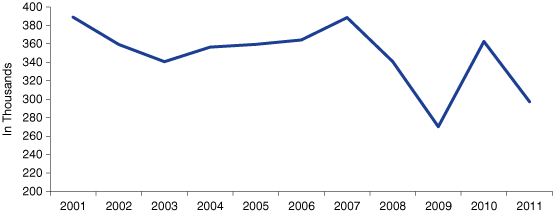Indiana Recession Employment Patterns
A recent opinion piece appearing on CNN online presented an argument looking at national trends indicating a labor market shift from fixed and stable employment to that of a turbulent market.1 Using Bureau of Labor Statistics (BLS) national numbers as a basis, the author suggested that in the future our workforce will be more transient with people working multiple temporary jobs in order to maintain a specific standard of living. The argument was made that the "Great Recession" re-enforced and escalated this trend.
Given the availability of micro wage data contained in the Indiana Workforce Information System (IWIS) back to 2001, an attempt was made to analyze the data to verify this claim.2 Second quarter employment data were used to prevent the influence of seasonal employment trends associated with either the holidays or late summer.
The first analysis examined the author's claim of increased levels of temporary work and multiple job holders. The total number of Indiana employees for the second quarter of each year totaled approximately 3 million employees. Of the identified individuals, the total with multiple employers was also summed. Less than 14 percent of workers in Indiana held multiple jobs and that percentage declined during the recession years in both percentage and absolute terms (see Figure 1 and Figure 2).
Figure 1: Percent of Indiana Employees with Multiple Employers, 2001 to 2011

Source: Indiana Department of Workforce Development, using IWIS data
Figure 2: Indiana Employees with Multiple Employers, 2001 to 2011

Source: Indiana Department of Workforce Development, using IWIS data
The second analysis examined labor force churn. Again, the total number of employees for the second quarter of each year was counted. Using these unique individuals, the prior year's wage record was also examined to determine how many held employment at the same employer. The results indicated that a growing percentage of workers maintained their place of employment in recession years (see Figure 3 and Figure 4).
Figure 3: Percent of Indiana Employees with Same Employer from Previous Year, 2002 to 2011

Source: Indiana Department of Workforce Development, using IWIS data
Figure 4: Indiana Employees with Same Employer from Previous Year, 2002 to 2011

Source: Indiana Department of Workforce Development, using IWIS data
While these results are Indiana specific, they run counter to the claims presented in the article. The recent recession possibly shed the most mobile workers first. Those that remained were more likely to reside longer at the position. As the recession took hold, extra hours and side jobs likely disappeared as people focused on core employment, or one of the positions was lost in favor of another. The Indiana data suggest that the recession was witness to fewer multiple job holders and less churn.
Notes
- LZ Granderson, "The fastest-growing job in America," CNN Opinion, March 13, 2012, www.cnn.com/2012/03/13/opinion/granderson-hustling-for-work/index.html.
- The available data includes wage records for firms with employees which are subject to Indiana unemployment tax
Timothy E. Zimmer, Ph.D.
Manager, Research and Analysis Division of the Indiana Department of Workforce Development
